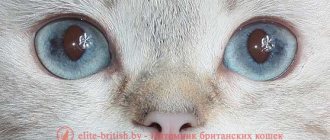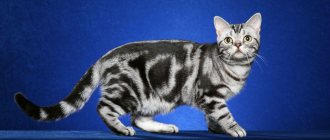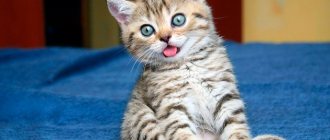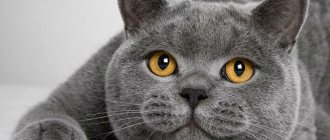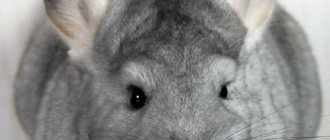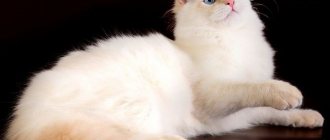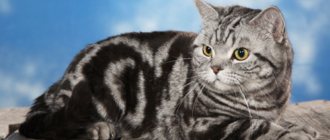Solid colors
There are two basic colors of cats - black
and
red
(red).
Both colors are formed due to the action of a special pigment, melanin. There are two types of melanin: one of them is responsible for the black color and is called eumelanin
, and the other is responsible for the red color and is called
pheomelanin
.
Black colors
are determined by the following genes:
B
(black) - black,
b
(brown) - brown,
bl
(brown light) - light brown.
Chromosomes are paired together, so cats have two of each type of gene. Couple BB
defines black color.
Similarly: bb
– chocolate color,
blbl
– cinnamon or sorrel.
Gene B
is “stronger” than genes
b
and
bl
, which is why it is called dominant.
And the b
, in turn, is stronger than the
bl
.
B
from one parent , and the recessive gene
B
, then its color will be black.
D gene is responsible for color saturation
(dense) and its recessive “companion”
d
(diluted).
These genes act as follows: BBDD
– black cat,
BBdd
– gray (blue).
Since the D
is dominant to
d
BBDd
cat will be black.
With red colors
everything is similar to a certain extent.
There is a dominant gene O
(orange) and a recessive
gene
O. OO
– red cat,
OO
– black cat,
OO
– tortoiseshell cat, i.e. black with red spots.
In combination with D
and
d
:
OODD
– bright red (red) cat,
OOdd
– cream cat.
The red color is said to be a sex-linked
.
O
and
O
genes are located only on
the X chromosome
.
Cats have two X chromosomes: XX, and cats have one X and one Y chromosome: XY. Males, therefore, have only one red color gene and can only be black (X o
Y_) or red (X
O
Y_). Tortoiseshell cats are extremely rare - they have not two chromosomes, but three: XXY. Such cats are infertile.
|
|
|
|
Color on the fur of cats
There are two basic cat colors: black and red. The remaining colors are a mixture of genes responsible for melanin, a special pigment that forms different shades of colors.
All coat colors of domestic cats come from only a few basic colors, which when mixed produce different shades. Most colors are found in both outbred and purebred animals, but the selective work of breeders has led to the fact that some of their types can appear only in cats of a certain breed. At the moment, the concept of color covers the color of an animal’s coat, various degrees of coloration, as well as the pattern on the coat.
White color in cats
It is believed that white cats bring happiness to the home. Wool of this color is found in representatives of different breeds. Snow-white Persian cats, especially blue-eyed ones, are highly valued. White cats with different colored eyes are extremely rare.
Among white cats, there are those with blue eyes - sometimes this is a sign of poor hearing or even deafness.
Photos of white cats of various breeds
Photo of the Highland Fold breed white color
Photo of a white oriental breed kitten
Gray (blue)
There are legends according to which cats with silver fur are the best protectors from trouble. They protect the home and bring happiness. Among silver colors, the most common is smoky, in which the hairs at the roots are painted white and closer to the tips - gray. The most famous representatives of the gray color include cats of the British breed with green and orange eyes.
Photos of cats (cats) of blue (gray) color
Photo of a cat of the British breed blue color
Photo of a Russian Blue cat
Tortoiseshell color
Pets with a similar coat color have a combination of random spots of tan (red) and black tones throughout the body. There are practically no inclusions of white color. The pattern on the fur is formed randomly from these colors, so that a complex and unique color is formed for the pet. It is interesting that tortoiseshell color is found almost exclusively in cats.
Color in animals is formed at the genetic level. Cats naturally have two X chromosomes, while cats have one X and one Y chromosome. Since the X chromosome is responsible for the formation of red and black coat colors, the appearance of a red-black combination in cats is high.
In cats, one of the colors appears, and therefore the tortoiseshell cat is considered an anomalous phenomenon. They usually have violations of the genetic code, suffer from pathologies of the endocrine and reproductive systems, and live no more than two to three years.
Black
Mysticism and superstition have surrounded cats of this color since ancient times. Whatever they were called: accomplices of Satan, talismans of magicians and witches. Some people even today believe in the sign of a black cat crossing the road and promising an unlucky day. In Scotland, on the contrary, black pets are respected, believing that they attract wealth. It is widely believed that black pets can heal illnesses and bring peace to the family.
Two-color
Officially, two-tone color (bicolor) was recognized quite recently; before that, such cats were considered as defective. These pets are believed to have a friendly nature. Two colors in color are often found in cats of Persian and British breeds. Breeders are happy to breed Angora and Siberian cats - the variety of their colors allows you to get kittens of the most unusual colors.
Ginger
Since ancient times, red cats have been considered healers and protectors. The “sunny” beast, according to legend, brings wealth, fun and joy to its owners. Red cats are considered very cunning. Red-haired robbers do not let their owners get bored, they are constantly playing pranks. At the same time, they are very affectionate.
Tricolor color in cats
Calico cats are believed to bring good luck. White pets with red and black spots are especially popular. In Japan, a figurine of a tricolor cat with a vertically raised paw is placed at the entrance to the house: then it will bring wealth and prosperity to the owners. It is surprising that among the animals marked with this color, there are almost no males.
Tabby colors
| There is a gene A (agouti), which provides zonal coloring of each hair, or ticking. Tabby pattern is determined by T and BBTTaa - uniformly colored black cat, Under the influence of gene d Tabby colors, like solid colors, are lightened. |
Ticked wool can form three types of patterns:
- brindle or striped tabby ( mackerel tabby
), - marbled tabby ( classic tabby
,
blotched tabby
), - spotted tabby
_
Gene T
determines the striped pattern, the
Tb
- marbled.
Scientists have not come to a consensus regarding which gene is responsible for the spotted tabby pattern. It has been suggested that the spotted pattern is determined by the same T
as the striped pattern, and that the fact that the stripes are “broken” is the result of the influence of polygenes. There is also a 4th variant of tabby color: the so-called tabby without stripes. It is found only in Abyssinian and British cats.
| Striped Tabby: | Marble Tabby: | Spotted Tabby: |
Tan (red) and cream cats ALWAYS have a tabby pattern. In cream cats it is barely noticeable.
Tabby color can be combined with tortoiseshell:
| Tabby turtle: | Tabby turtle with white: | Marbled Tabby Tortoise with White: |
British Cream color standard
The color standard for British shorthair cats includes the following parameters:
- tortoiseshell colors combine red and black shades;
- Smoky color is characterized by suppression of pigment in the root area and a brighter color at the tip of the hair;
- The tabby trait appears as a striped pattern on the main shade of the coat;
- bicolors combine white with other combinations.
For solid colors (solid), certain rules were also established - the hair is uniformly pigmented along its entire length, the coat has no shade transitions. Areas of a different color are missing.
The classic color of this group is blue-gray. Next come black, white, lilac, chocolate shades. The list of solid colors is completed by the British cream cat.
Appearance
There is disagreement in international felinological associations regarding the definition of cream coat color in cats.
- Europeans give the palm to animals with fur coats of a very bleached red hue.
- The American version is a richer, thicker color.
- English breeders are of the opinion that any shade of cream has the right to exist. The main thing is to preserve the potential of the native breed.
- Eyes in honey, amber or orange shades. The breed standard does not allow cream Britons with green, blue or different (heterochromia) eyes.
- The nose and paw pads should be reddish-pink in color, without foreign inclusions.
Cream kittens are often born with a tabby pattern, but later recolor. The tabby color disappears completely or becomes almost invisible. But if the cream color of a British cat is combined with a pronounced tabby, such animals are rejected from breeding work and are not allowed to participate in exhibitions.
Unevenly colored coat is also considered a serious reason for the disqualification of a solid-colored British cat.
This is interesting! The coat color of the British Cream breed depends on the ambient temperature. At high values the shade becomes lighter, at low values it becomes darker.
Eyes, nose, paw pads
In addition to its unusual color, the British cream cat differs from other representatives of the breed in the following external characteristics:
This is interesting! At first, the British rejected cats with this coat color because they considered it a defect in the red color.
White spot
The presence of white spots is determined by a white spotting gene or possibly a group of genes. The amount of white in the color may vary:
- Van
: almost white cat; Only the tail is colored and there are colored markings on the head. - Harlequin
: About 1/5 of the cat's total body surface is colored. Individual large spots are located on the back, head and sides. The tail is completely colored. - Bicolor
: about half of the entire body surface is colored. - Marquis
: there is very little white: there are white “gloves” and “slippers” on the paws, a white medallion on the chest.
Painted areas can be any color: solid red or black, various variations of tabby patterns, tortoiseshell, etc.
| Wang | Harlequin | Cream bicolor |
| Black bicolor | Gray (blue) bicolor | Tabby bicolor |
| Intermediate color between bicolor and marquise | Cream marquise | Black Marquis |
White cats
The white color of a cat is most often determined by the presence of the dominant W
.
This gene blocks the work of other, “colored” genes ( B
,
T
,
A
,
O
etc.). However, these genes are present in any white cat and can be expressed in the offspring. They are also manifested by the presence of small colored spots on the head of white kittens. By the age of one year, these spots disappear.
For example, cat Bb Dd TT aa Ww
would be white, and if instead of the
W
had its recessive “companion”
w
(i.e. not
Ww
, but
ww
), she would be solid black (the presence of merle color genes
T
in this case does not affect the color of -due to the fact that the agouti gene is represented by the recessive allele
a
).
|
|
The white gene also affects eye pigmentation and can cause hearing problems. According to another version, this gene does not itself cause deafness, but turns out to be linked to the genes that cause it.
White color can also be caused by the presence of the albinism gene. Albinos are extremely rare. Albino cats have light blue or red eyes.
Lena Lenina's pink kitten turned out to be a cat
There was recently a rumor on the Internet: supposedly Lena Lenina’s kitten died after she painted it pink with poisonous paint.
There was recently a rumor on the Internet: supposedly Lena Lenina’s kitten died after she painted it pink with poisonous paint and dragged it to a party where everyone was wearing pink. After a wave of indignation swept across social networks, new details of this story surfaced, unexpectedly instilling optimism and faith in people.
It turns out that the gossips confused the gender of the animal: it is not a cat, but a she-cat. And it does not belong to Lenina at all. The situation developed as follows: in September last year, Lenina gave a cat to Bari Alibasov, but he already had a Sphynx cat living at home, and he was hostile to the appearance of his supposed girlfriend. Alibasov was forced to give the cat to a friend who runs a Moscow restaurant. But the animal did not find happiness with him either: the restaurateur quickly gave the cat to his friend named Regina.
The little animal, of course, was painted for a party, no one denies this - but, as Lenina claimed from the very beginning, with a harmless dye. True, very strong - he went away for six months. But now, thank God, it’s almost gone, and the cat has regained its original white color.
Lenina is now showing her spiteful critics photographs of a living and healthy cat, and is also going to punish especially cruel slanderers - for this she has already hired a lawyer.
New details have become known about the fate of the animal that was buried on the Internet.
The girl Regina, who owns the little cat, is also not herself:
“People have absolutely no common sense.” They don’t understand that the cat couldn’t have become fatally ill from painting six months after painting. It’s outrageous, but none of the journalists contacted me, as the cat’s owner, and asked whether she was alive. But everyone is noisily burying it in the press. This is very painful for me. In general, the whole story is similar to an “order” against Lenina - although, if you think sensibly, she has nothing special to do with this cat, except that she held it in her hands a couple of times. Probably someone decided to promote themselves at her expense. It’s sad that people believe everything the yellow press writes, which doesn’t even check the information, but makes money from such scandals. I’m very sorry for Lena, who almost wanted to go to jail for my alive and healthy cat. How many cruel fools we have!
FROM THE HOURS
Lena Lenina: “Stop lying! The kitten is alive and well!
The outrageous writer is in a hurry to refute the attacks of animal rights activists who reported the death of the animal
The scandal that happened after last year’s “In Pink” party, which was hosted by a famous showwoman, seems to have continued. Initiative and not indifferent to the fate of the tiny kitten that Lena Lenina used as an accessory at that same ill-fated evening, they tracked its fate. (details)
THERE WAS ANOTHER CASE
In Yekaterinburg, our little brothers are painted to look like dragons, bees and supermen
Innovative stylists claim that it is completely harmless. Cats and dogs are transformed thanks to paint that does not contain ammonia
An acid green dragon, a giant bee and a mini zebra have already shocked the residents of Yekaterinburg. But as soon as you get closer to these amazing creatures, your hands will reach out to stroke them. After all, under the flashy “clothes” hide our charming little brothers. (details)
Color point colors
A color point cat has a light body and colored points (from the English point
– extremity, tip). Points include the ends of the paws, ears, tail, and the tip of the muzzle. The gene responsible for the color point color blocks the action of other genes only partially: these genes manifest themselves in the color point color. The color of the points can be any - classic black (seal point), blue, red, cream. Points may have a tabby pattern. If the white spotting gene is present, a color point cat may have white spots.
| Classic Siamese color: seal point | Seal point with white spots | Blue Point |
| Red point | Tortie point (turtle + color point) | Blue Tabby Point |
The gene responsible for the color point color also gives blue eye color.
